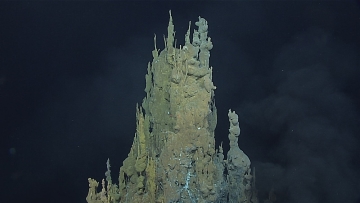681023_Living in Chimneys_360 px width.jpg

Thousands of microscopic organisms can inhabit chimneys that form on the ocean floor. Credit: NOAA/OAR/OER.
Many species of marine life are spread far and wide—across millions of square miles. But others are concentrated in patches no bigger than your backyard garden. And thousands of species can share the space.
Some of these patches surround small structures known as chimneys—columns of rock that form when jets of super-hot water shoot up from below the ocean floor. When the mineral-rich water hits the cold ocean water, the minerals build pillars of rock that can be many feet tall.
Microscopic organisms thrive in these environments. Many species are found around chimneys across the world. But other species are found only in their own little patches.
A recent study, for example, discovered more than 150 species around a single chimney that haven’t been seen anywhere else. It’s on Brothers Seamount, an underwater volcano near New Zealand.
Researchers used state-of-the-art techniques to sequence the genomes of microbes from the chimney. They did the same thing for microbes found in four large patches of chimneys in the Pacific and Atlantic oceans. In all, they logged more than 3500 species of microscopic life. The list included hundreds of species that had never been seen before.
The study also found that many of the organisms depend on each other to survive. Some, for example, can’t get all the nutrients they need on their own. So they depend on other organisms to provide those nutrients—in their own little garden patches on the ocean floor.

